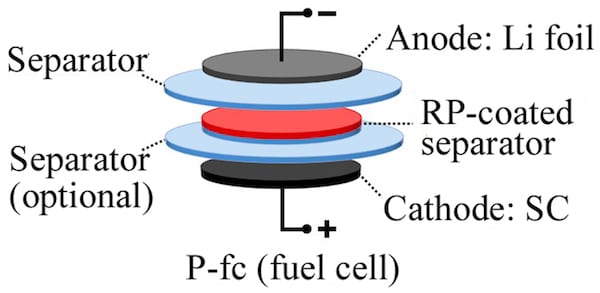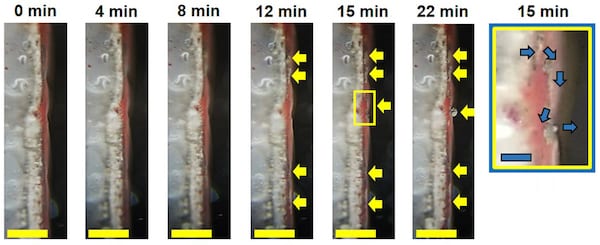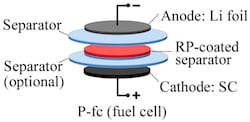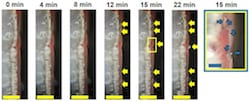NEWS RELEASE
Editor’s note: Links to high-resolution images for download appear at the end of this release.
Jeff Falk
713-348-6775
jfalk@rice.edu
Mike Williams
713-348-6728
mikewilliams@rice.edu
Better red than dread: Barrier keeps batteries safe
Rice University scientists use red phosphorus as spy to keep lithium dendrites in check
HOUSTON – (Feb. 14, 2018) – Rice University scientists have taken the next step toward the deployment of powerful, rechargeable lithium metal batteries by making them safer and simpler to manufacture.
The Rice lab of chemist James Tour made test cells with a coat of red phosphorus on the separator that keeps the anode and cathode electrodes apart. The phosphorus acts as a spy for management systems used to charge and monitor batteries by detecting the formation of dendrites, protrusions of lithium that can cause them to fail.

A layer of red phosphorus in rechargeable lithium metal batteries can signal when damaging dendrites threaten to create a short circuit. The technique developed at Rice University could lead to more powerful lithium metal batteries. Courtesy of the Tour Group
Lithium metal anodes charge much faster and hold about 10 times more energy by volume than common lithium-ion anodes used in just about every electronic device on the market, including cellphones and electric cars. Anodes are one of two electrodes needed for battery operation.
But charging lithium-infused anodes forms dendrites that, if they reach the cathode, cause a short circuit and possibly a fire or explosion. When a dendrite reaches a red phosphorus-coated separator, the battery’s charging voltage changes. That tells the battery management system to stop charging.
Unlike other proposed dendrite detectors, the Rice strategy doesn’t require a third electrode.
“Manufacturing batteries with a third electrode is very hard,” Tour said. “We propose a static layer that gives a spike in the voltage while the battery is charging. That spike is a signal to shut it down.”
The research appears in Advanced Materials.
The red phosphorus layer had no significant effect on normal performance in experiments on test batteries by the Tour lab.
The researchers built a transparent test cell with an electrolyte (the liquid or gel-like material between the electrodes and around the separator that allows the battery to generate a current) known to accelerate aging of the cathode and encourage dendrite growth. That let them monitor the voltage while they watched dendrites grow.
With an ordinary separator, they saw the dendrites contact and penetrate the separator with no change in voltage, a situation that would lead a normal battery to fail. But with the red phosphorus layer, they observed a sharp drop in voltage when the dendrites contacted the separator.
“As soon as a growing dendrite touches the red phosphorus, it gives a signal in the charging voltage,” Tour said. “When the battery management system senses that, it can say, ‘Stop charging, don’t use.'”

Images of a half-cell lithium metal battery show dendrites approaching a red phosphorus separator. The separator delivers a signal to the battery’s electronics to shut down when dendrites threaten to create a short circuit. The discovery by scientists at Rice University could help make lithium batteries safer. Courtesy of the Tour Group
Last year, the lab introduced carbon nanotube films that appear to completely halt dendrite growth from lithium metal anodes.
“By combining the two recent advances, the growth of lithium dendrites can be mitigated, and there is an internal insurance policy that the battery will shut down in the unlikely event that even a single dendrite will start to grow toward the cathode,” Tour said.
“Literally, when you make a new battery, you’re making over a billion of them,” he said. “Might a couple of those fail? It only takes a few fires for people to get really antsy. Our work provides a further guarantee for battery safety. We’re proposing another layer of protection that should be simple to implement.”
Rice graduate student Tuo Wang is lead author of the paper and postdoctoral researcher Rodrigo Salvatierra is co-author. Tour is the T.T. and W.F. Chao Chair in Chemistry as well as a professor of computer science and of materials science and nanoengineering at Rice.
The Air Force Office of Scientific Research supported the research.
-30-
Read the abstract at https://onlinelibrary.wiley.com/doi/10.1002/adma.201807405.
Follow Rice News and Media Relations via Twitter @RiceUNews.
Related materials:
Nanotubes may give the world better batteries: http://news.rice.edu/2018/10/25/nanotubes-may-give-the-world-better-batteries-2/
Graphene-nanotube hybrid boosts lithium metal batteries: http://news.rice.edu/2017/05/18/graphene-nanotube-hybrid-boosts-lithium-metal-batteries-2/
Tour Group: https://www.jmtour.com
Department of Chemistry: https://chemistry.rice.edu
Wiess School of Natural Sciences: https://naturalsciences.rice.edu
Images for download:
https://news2.rice.edu/files/2019/02/0218_DETECT-1-WEB-1e7325s.jpg
A layer of red phosphorus in rechargeable lithium metal batteries can signal when damaging dendrites threaten to create a short circuit. The technique developed at Rice University could lead to more powerful lithium metal batteries. (Credit: Tour Group/Rice University)
https://news2.rice.edu/files/2019/02/0218_DETECT-2-WEB-1gk6u0g.jpg
Images of a half-cell lithium metal battery show dendrites approaching a red phosphorus separator. The separator delivers a signal to the battery’s electronics to shut down when dendrites threaten to create a short circuit. The discovery by scientists at Rice University could help make lithium batteries safer. (Credit: Tour Group/Rice University)
Located on a 300-acre forested campus in Houston, Rice University is consistently ranked among the nation’s top 20 universities by U.S. News & World Report. Rice has highly respected schools of Architecture, Business, Continuing Studies, Engineering, Humanities, Music, Natural Sciences and Social Sciences and is home to the Baker Institute for Public Policy. With 3,962 undergraduates and 3,027 graduate students, Rice’s undergraduate student-to-faculty ratio is just under 6-to-1. Its residential college system builds close-knit communities and lifelong friendships, just one reason why Rice is ranked No. 1 for lots of race/class interaction and No. 2 for quality of life by the Princeton Review. Rice is also rated as a best value among private universities by Kiplinger’s Personal Finance. To read “What they’re saying about Rice,” go to http://tinyurl.com/RiceUniversityoverview.



